Fire Succession on the B-area
Eric R. Pianka -- Fire Succession on the B-area
Fire Succession on the B-area
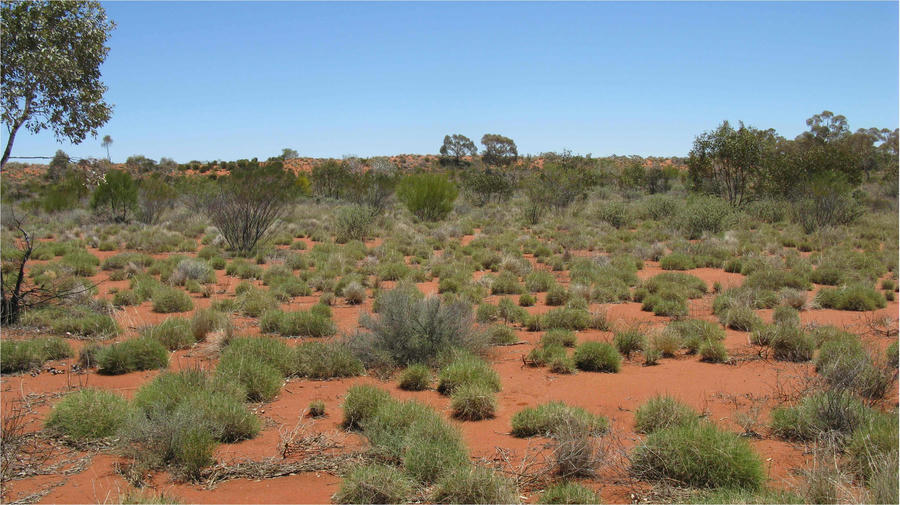
© Eric R. Pianka
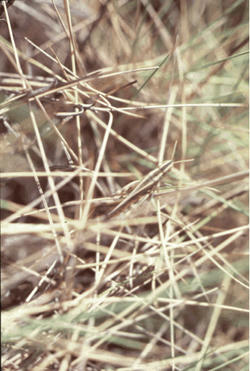
The very flammable hummock grass plant life form is unique to Australia. Spinifex tussocks are almost perfectly designed for combustion, consisting of hemispherical clumps of numerous match stick sized, curled blades of dry grass filled with flammable resins, loosely interpenetrating one another and laced with ample air spaces. With such ideal tinder (on a scale of 1 to 10 as as measure of perfect tinder, spinifex gets a 9), one match will often start a raging bonfire. Spinifex has been called an ideal pyrophyte. Spinifex is an exceedingly important habitat element for many species of Australian desert lizards. Individuals of most species take refuge in spinifex from predators and the sun. Some species occur only in large long unburned tussocks.

 Martu hunter burning spinifex to find Sand Monitor
lizards. Spinifex fires can be extensive (Photo by Allan Fox).
Varanus gouldii (Photo courtesy Rebecca Bliege Bird) Most fires are started
by lightning, and can burn for weeks across thousands of square kilometers of
uninhabited desert. Australia is probably the last place on Earth where
wildfires are allowed to rage completely out of control. Wildlife managers in
Australia try to optimize fires to create a fine-grained patchwork of habitats
of different ages. Fires vary considerably in intensity as well as extent. In
1992-94, we undertook a detailed landscape-level remote sensing study of
wildfires as agents of disturbance promoting habitat diversity in the Great
Victoria Desert of Western Australia using satellite imagery (Haydon et al.
2000a, 2000b). About 450 fires occurred in each
of two Landsat scenes over the 20 year period from 1972 to 1992, but we found
very little reburn. Fire return interval for vegetation was estimated to be
about 20 years.
Martu hunter burning spinifex to find Sand Monitor
lizards. Spinifex fires can be extensive (Photo by Allan Fox).
Varanus gouldii (Photo courtesy Rebecca Bliege Bird) Most fires are started
by lightning, and can burn for weeks across thousands of square kilometers of
uninhabited desert. Australia is probably the last place on Earth where
wildfires are allowed to rage completely out of control. Wildlife managers in
Australia try to optimize fires to create a fine-grained patchwork of habitats
of different ages. Fires vary considerably in intensity as well as extent. In
1992-94, we undertook a detailed landscape-level remote sensing study of
wildfires as agents of disturbance promoting habitat diversity in the Great
Victoria Desert of Western Australia using satellite imagery (Haydon et al.
2000a, 2000b). About 450 fires occurred in each
of two Landsat scenes over the 20 year period from 1972 to 1992, but we found
very little reburn. Fire return interval for vegetation was estimated to be
about 20 years.

Most fire studies use a chronosequence method using areas known to have burned
at different times (e.g., see Masters
1996. This allows many years
worth of data to be collected during a short time. While useful, this method
has clear limitations because of confounding factors involving differences
among study plots. Differences between recently burned and long since burned
plots may have different biological properties for many reasons; including soil
chemistry, topology, or even proximity to other sites with very different
physical or biological properties. To avoid such problems, I undertook a
longitudinal long-term study at one site, although, of course, limits on
manpower dictated that it could not be replicated. 1
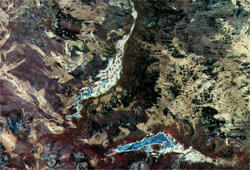 Following a fire, spinifex rejuvenates rapidly from live
roots as well as by seedling establishment. Newly-burned areas are very open
and consist mostly of bare ground covered with tiny, well-spaced, clumps of
spinifex. Unburned patches, in contrast, are composed of large ancient
tussocks, frequently close together with little or no open space between them.
Effects on lizards and lizard microhabitats are drastic, yet vary in time and
location. Many or even most individual lizards live through the burn itself,
only to succumb in the fire-reduced habitats and microhabitats that can last
for years. Some lizard species with open habitat requirements reinvade and
repopulate burned areas rapidly. Other species that require large spinifex
tussocks for microhabitats often become very rare or even vanish altogether
after a burn. However, such 'climax' species (those living in long-undisturbed
habitat) can continue to exist in isolated pockets and patches of unburned
habitat. Fires thus create a habitat patchwork, increasingly recognized as a
major contributor to species richness (Pianka 1989,
1996). Indeed, wildlife managers in Australia use controlled
burns to attempt to maintain an appropriate fine-grained mixture of habitats of
different ages since fire.
Following a fire, spinifex rejuvenates rapidly from live
roots as well as by seedling establishment. Newly-burned areas are very open
and consist mostly of bare ground covered with tiny, well-spaced, clumps of
spinifex. Unburned patches, in contrast, are composed of large ancient
tussocks, frequently close together with little or no open space between them.
Effects on lizards and lizard microhabitats are drastic, yet vary in time and
location. Many or even most individual lizards live through the burn itself,
only to succumb in the fire-reduced habitats and microhabitats that can last
for years. Some lizard species with open habitat requirements reinvade and
repopulate burned areas rapidly. Other species that require large spinifex
tussocks for microhabitats often become very rare or even vanish altogether
after a burn. However, such 'climax' species (those living in long-undisturbed
habitat) can continue to exist in isolated pockets and patches of unburned
habitat. Fires thus create a habitat patchwork, increasingly recognized as a
major contributor to species richness (Pianka 1989,
1996). Indeed, wildlife managers in Australia use controlled
burns to attempt to maintain an appropriate fine-grained mixture of habitats of
different ages since fire.
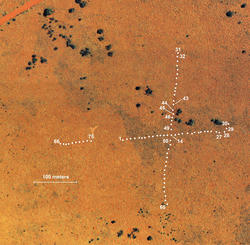
In the Austral Spring of 1992, I decided to undertake an imperfect experiment, without replication, and set up a new study site, the B-area, with pit trap lines and drift fences, monitoring it before and after a controlled burn, shown in the above high resolution aerial photograph taken on 17 February 1993. Positions of 75 pit traps are shown with solid white circles, along with a scale. Hundreds of termitaria, circular open areas about the same size as pit trap circles, are scattered about the image. Notice the patches of older long unburned spinifex embedded within larger patches burned more recently. The main east-west track from Laverton WA to Coober Pedy SA via Neale Junction is in the northwest (upper left hand) corner.
Pre-burn (long unburned) pit trap samples were collected for 3 months in 1992.
A controlled burn was undertaken at this study site in October 1995 and the
site has been monitored at regular intervals following the fire during 1995-96,
1998, 2003, and 2008 to assess changes in community structure. Lizard censuses
from an unburned site 4 km north of the experimental burn site (the R-area) can
be considered a partial control, as they provide a reference for understanding
population and community change in relation to fire on the B-area.


A few dozen scattered tussocks escaped the fire, providing limited refuges for
surviving lizards. Immediately after the controlled burn, the area was walked
searching for lizard fire victims but very few were found. Most lizards
survived the fire by escaping into burrows. Pits were opened without drift
fences for one month in late 1995 and again for two weeks in January 1996. The
seven most abundant lizard species were two agamids Ctenophorus isolepis and
Ctenophorus nuchalis, and five Ctenotus skinks, C. ariadnae, C. calurus,
C. hanloni, C. pantherinus, and C. piankai. Abundances varied considerably
through the course of the fire succession cycle. Most striking, abundances of
the two agamids C. isolepis and C. nuchalis were negatively correlated,
fluctuating out of phase inversely with each other, with C. nuchalis reaching
very high population densities immediately after each burn, whereas C.
isolepis densities diminished after fires and were more abundant in unburned
or recovering vegetation cover.
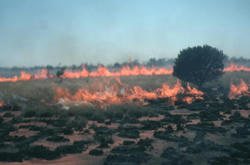
Lizard faunas and foods eaten on the B-area have been examined at 7 different time intervals in the fire succession cycle from original long-unburned to 16 years post-burn to better understand the dynamics of this ecosystem. These long-term census data provide valuable insights into how individual species respond (species composition, relative abundance, dietary flexibility, and reproductive tactics). A total of 2872 individual lizards representing some 46 species have been collected at the B-area from 1992 through 2008.
Table. Number of species and individuals (in parentheses) in 5 lizard families
captured at various times during the fire succession cycle. Also given are the
total number of species and total number of individuals, along with number of
trap days and number of lizards captured per trap day. Lizard species
diversities calculated with Simpson's index are based on relative abundance
